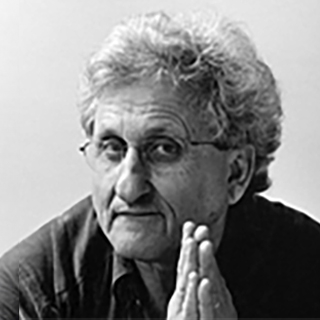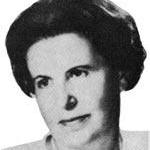The Retrospective
Published in Issue #10 Translated from Hebrew by Stuart SchoffmanExcerpt from a Novel
Moses and Ruth exit the municipal palace, and Moses hurries toward the striking sanitation workers to congratulate them on their spirited performance. And in light of the day’s crowded schedule, he suggests that before the meeting with the institute teachers, he and Ruth take a walk in the Old Town. It is a great pleasure to wander aimlessly in narrow streets that suddenly become little plazas with statues, to peek into hidden gardens. The pure, refreshing air reddens Ruth’s cheeks, and her eyes shine. Outside of Israel she does not expect to be recognized; she can walk around relaxed, without wondering if someone will come up and ask if it’s really her.
The souvenir shops here are so numerous and well stocked that it seems sinful not to take home some knickknack, proof for their twilight years that the trip to Santiago was not just a dream. Moses chooses two traditional walking sticks of blackish bamboo, each with an iron tip to stick in the ground for support, and topped by a big reddish shell, the shell of Saint James, in honor of the angel who steered the shell-shaped ship bearing the body of the saint to the shores of the village of Padrón.
“What do I do with a stick like this?” She laughs.
“You can lean on it when I’m no longer at your side.”
When they return to the hotel they find de Viola, the director of the archive, in civilian clothes, waiting beside his small car. He was gratified by the conversation in the mayor’s office. It’s good that foreign artists honor the city fathers, since unlike the locals, the guests cannot be suspected of ulterior motives. Spread under the sharp blue sky, the vast pilgrim plaza is empty now. The sanitation workers have gone for their siesta, and a bored lone policeman waits for them to come back.
The drive to the film institute takes a while. It is located outside the city limits but exploits its famous name to attract students and visitors. The car heads west, toward the Atlantic coast.
During the reign of Franco, a native of the region of Galicia, the building that now houses the institute functioned as an army barracks. Located in an open area that offers a plethora of parking spots, it provides ample space — three screening rooms of varying size, dining halls, studios and classrooms, and dormitories for students. Even so, exchanging the stately old palaces and glorious cathedral for the nondescript quarters of his retrospective depresses the Israeli director a bit.
In the staff dining room, a large table has been set, around which a small group of senior faculty await him, men and women of various ages. As he feels their warm welcome, his mood improves, and after everyone present introduces himself by name and specialty, a simple but generous meal is served, with vestigial flavors, or so it seems, of army food.
De Viola doesn’t want to waste time with small talk. Having seated those who know English well next to those who do not, he taps a knife on his wineglass without waiting for dessert and poses a question of aesthetics so urgently that Moses almost suspects it was the sole purpose he was invited to a retrospective at this provincial archive.
“We welcome you with pleasure and interest and thank you for taking the trouble to travel so far to your retrospective,” begins de Viola, “a retrospective where we shall screen primarily films from the early period of your creative work. We will discuss them one by one after each screening, but a general question has arisen regarding the sharp stylistic shift that took place in your films. It seems to us, Mr. Moses, that in the past two decades you have turned your back on the surrealistic and symbolic style of your early films and have become addicted to extreme realism that is almost naturalistic. The question is simple: Why? Do you no longer believe in a world of transcendence, in what is hidden, invisible, and fantastical, so much so that you are mired in the mundane and the obvious? For example, in the film Potatoes, which you made five years ago, your main characters eat lunch for sixteen minutes.”
“Eighteen minutes,” Moses corrects him, impressed that a stranger in a distant land is such an expert on a recent film of his, “if you count the two minutes I made the audience watch the table being cleared and the dishes washed.”
“True,” proclaims the priest triumphantly, “I even remember the hesitation of the Arab waiter as he wondered whether to empty the plate into the garbage can or salvage the leftovers in a container for the poor of his village. Yet this long meal scene is within a film that is not especially long. One hundred and twenty minutes?”
“One twenty-three,” notes the director for the record, again with a smile.
Whereupon a young teacher, pale and handsome, raises his hand to push de Viola’s question further.
“There is a feeling, sir, that in your latest films, the material aspect has assumed supreme importance, and not necessarily out of a new aesthetic. As if you are sanctifying the materialism of the world or succumbing to it, whether in lengthy cinematographic takes of locations and landscapes or in the physical appearances of people. You slow down movement and employ extreme close-ups to dwell on the most banal things. Sometimes the camera spends an entire minute following the gesticulation of a speaker without showing his face. Sometimes, in a long dialogue scene, we see just one of the speakers; the other we only hear. Does not such naturalistic realism smother any possibility of mystery, of rising to a higher vision? Have you permanently broken away from the strange, the absurd and grotesque, the elements that were so important and well developed in your early films?”
Moses has heard such sentiments in his home country as well as abroad, though here the questions seem tinged by a certain antagonism. And as the English speakers finish translating for their friends, there is a murmur of general agreement, after which the room falls silent in anticipation of an answer. The director exchanges a quick glance with his companion. Trusty Ruth, her eyes sparkling, knows the answers to come. And Moses feels that despite the many years that have gone by since Trigano first introduced her to him as his friend and lover, her beauty has not faded, and it holds a clear advantage over the looks of the two chic young teachers sitting alongside her.
For a moment Moses considers rising to his feet, to add force to his response, but the female hand placed gently on his knee keeps him in his seat.
“Yes, ladies and gentlemen” — he smiles serenely — “I am familiar with this contention and taste its hint of bitterness. Yet in recent years I have witnessed a new phenomenon among filmgoers, especially those considered intelligent and perceptive. I have a name for this phenomenon: the Instant White-Out. People are closeted in cozy darkness; they turn off their mobile phones and willingly give themselves, for ninety minutes or two hours, to a new film that got a four-star rating in the newspaper. They follow the pictures and the plot, understand what is spoken either in the original tongue or via dubbing or subtitles, enjoy lush locations and clever scenes, and even if they find the story superficial or preposterous, it is not enough to pry them from their seats and make them leave the theater in the middle of the show.
“But something strange happens. After a short while, a week or two, sometimes even less, the film is whitened out, erased, as if it never happened. They can’t remember its name, or who the actors were, or the plot. The movie fades into the darkness of the movie house, and what remains is at most a ticket stub left accidentally in one’s pocket. A man and a woman sit down a few days after seeing a film together and try to squeeze out a memory of a scene, the face of an actor, the twist of a plot, but they come up with nothing. The movie is erased from memory. What happened? What changed? Is it because the TV shows dancing before us on dozens of channels reduce feature films to dust in the wind?
“Amazingly enough, live theater, no matter how weak or shallow the play, always manages to leave some impression. Of course, people don’t remember every turn of the story, and whole scenes are forgotten, but there’s something about the tangible reality of the stage or the living presence of actors that sticks in the memory for years, and like a locomotive it can pull a whole train out of the darkness. Therefore, in honor of the art of cinema, I have decided to combat forgetfulness by means of the staying power of materialism.
“I’ll give you an example. Three years ago, I saw a Korean or Vietnamese film about a village girl who gets pregnant and is determined to have an abortion but there’s no one she can trust not to expose her shame to the community. Eventually she convinces a young boy to help her, and by primitive, life-threatening means they succeed in aborting the fetus. But while the girl is writhing in pain, the director doesn’t back off; he forces the young man to look at the dead fetus, at four or five months of development, that lies on a towel in the bathroom. At first the camera lingers on the frightened face of the boy looking at the fetus, and then the director moves the lens toward the fetus itself, and suddenly the screen is filled with a creature, smeared with blood, that appears to be not an artificial prop but the real thing, an actual fetus. The camera stays on it for twenty seconds, which seems endless. Many viewers squirmed in their seats and averted their eyes, but I decided to meet the director’s challenge, and I saw, in that bloody mass, the image of a primal man, something in the chain of evolution, that looked dimly back at me and filled me with deep sorrow but also with strange excitement.
“The following day, I went to see the movie again, this time freed from the suspense of the plot. And when the bloody fetus on the bathroom floor again spoke to me of humanity brutally nipped in the bud, it was clear that despite the film’s simplistic story and amateurish acting, I would remember it to the end of my days. And I told myself that if I wanted a movie of mine not to be quickly erased from memory, I needed to strengthen it with something along the lines of this fetus.”
“Fetus?” says Pilar, as she leans to whisper translation to two teachers.
“Fetus as a symbol, a metaphor,” Ruth explains to her, knowing well both the story and its conclusion.
“Therefore,” continues Moses, “in recent years I have been using two cameras, and even three, to explore the realm of reality in search of the fetus that can never be forgotten. First I collect available morsels of reality, rare or commonplace, and then my scriptwriters and I choose the ones that can be strung together into a story.”
A tense silence falls among the film teachers, who try to fathom the depth of thought and technique while also eyeing the chocolate cake that has been placed in the middle of the table. Darkness deepens in the narrow windows, and for a moment Moses imagines he hears an echo of his words in the roar of a nearby ocean.
But when the housekeeper brings the coffee, the tension lifts. The visitor looks around with a reassuring smile, as if he’d been jesting all along, and those present respond in kind. Idle conversation has begun, a packet of slim Spanish cigarillos is passed around. Moses takes one, sucks the smoke with pleasure.
Prior to the screening, de Viola takes his guests on a quick tour of his little empire, the film archive that occupies the chilly basement of the barracks. First they visit the film lab, dominated by an old-fashioned editing table, still apparently in use, with film on its reels. Then they go to the modern editing rooms and see the big AVID computer and a row of screens. From there, they head for the up-to-date sound studio, where the dubbing is done, and then the director of the archive leads them down a narrow, chilly passageway, and on its shelves, instead of shells and bullets, are reels of old celluloid film. Before they ascend from the cellar, the host takes them for a peek at a small museum of the history of the barracks. Amid pictures on the wall of officers who killed one another in the Spanish Civil War dangle a few rusty pistols from the same era.
“Can they still shoot?” asks Ruth.
“Can they?” The priest laughs. “Maybe, but at whom? The dead are dead. And the living want to keep on living.”
Copyright © 2011 by Abraham B. Yehoshua
English translation copyright © 2013 by Stuart Schoffman
This novel, previously published in Hebrew, will be published in English next month by Houghton Mifflin Harcourt and can be purchased here.





